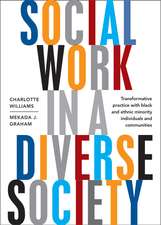Slim's Table: Race, Respectability, and Masculinity
Autor Mitchell Duneieren Limba Engleză Paperback – 28 mai 1994
At the Valois "See Your Food" cafeteria on Chicago's South Side, black and white men gather over cups of coffee and steam-table food. Mitchell Duneier, a sociologist, spent four years at the Valois writing this moving profile of the black men who congregate at "Slim's Table." Praised as "a marvelous study of those who should not be forgotten" by the Wall Street Journal,Slim's Table helps demolish the narrow sociological picture of black men and simple media-reinforced stereotypes. In between is a "respectable" citizenry, too often ignored and little understood.
"Slim's Table is an astonishment. Duneier manages to fling open windows of perception into what it means to be working-class black, how a caring community can proceed from the most ordinary transactions, all the while smashing media-induced stereotypes of the races and race relations."—Citation for Chicago Sun Times Chicago Book of the Year Award
"An instant classic of ethnography that will provoke debate and provide insight for years to come."—Michael Eric Dyson, Chicago Tribune
"Mr. Duneier sees the subjects of his study as people and he sees the scale of their lives as fully human, rather than as diminished versions of grander lives lived elsewhere by people of another color. . . . A welcome antidote to trends in both journalism and sociology."—Roger Wilkins, New York Times Book Review
"Slim's Table is an astonishment. Duneier manages to fling open windows of perception into what it means to be working-class black, how a caring community can proceed from the most ordinary transactions, all the while smashing media-induced stereotypes of the races and race relations."—Citation for Chicago Sun Times Chicago Book of the Year Award
"An instant classic of ethnography that will provoke debate and provide insight for years to come."—Michael Eric Dyson, Chicago Tribune
"Mr. Duneier sees the subjects of his study as people and he sees the scale of their lives as fully human, rather than as diminished versions of grander lives lived elsewhere by people of another color. . . . A welcome antidote to trends in both journalism and sociology."—Roger Wilkins, New York Times Book Review
Preț: 122.92 lei
Nou
Puncte Express: 184
Preț estimativ în valută:
23.52€ • 24.30$ • 19.57£
23.52€ • 24.30$ • 19.57£
Carte tipărită la comandă
Livrare economică 19 martie-02 aprilie
Preluare comenzi: 021 569.72.76
Specificații
ISBN-13: 9780226170312
ISBN-10: 0226170314
Pagini: 200
Ilustrații: 11 halftones
Dimensiuni: 140 x 216 x 15 mm
Greutate: 0.25 kg
Ediția:1
Editura: University of Chicago Press
Colecția University of Chicago Press
ISBN-10: 0226170314
Pagini: 200
Ilustrații: 11 halftones
Dimensiuni: 140 x 216 x 15 mm
Greutate: 0.25 kg
Ediția:1
Editura: University of Chicago Press
Colecția University of Chicago Press
Notă biografică
Mitchell Duneier is professor of sociology at Princeton University and visiting distinguished professor of sociology at the City University of New York. Ovie Carter, who took the photographs used in this book, won the Pulitzer Prize in 1975 for The Faces of Hunger.
Cuprins
Pt. One: The Caring Community
1. Slim and Bart
2. Black Men: Transcending Roles and Images
Pt. Two: The Moral Community
3. Valois as a "Black Metropolis"
4. The Standard of Respectability
Pt. Three: Membership in Society
5. Openness
6. The Need for Contact with Society
7. A Higher Self
Pt. Four: You're White, He's Black, I'm a Sociologist: Who's Innocent?
8. The Underclass and the Middle Class
9. The Stereotype of Blacks in Sociology and Journalism
10. Conclusion
Acknowledgments
Notes
Index
1. Slim and Bart
2. Black Men: Transcending Roles and Images
Pt. Two: The Moral Community
3. Valois as a "Black Metropolis"
4. The Standard of Respectability
Pt. Three: Membership in Society
5. Openness
6. The Need for Contact with Society
7. A Higher Self
Pt. Four: You're White, He's Black, I'm a Sociologist: Who's Innocent?
8. The Underclass and the Middle Class
9. The Stereotype of Blacks in Sociology and Journalism
10. Conclusion
Acknowledgments
Notes
Index














